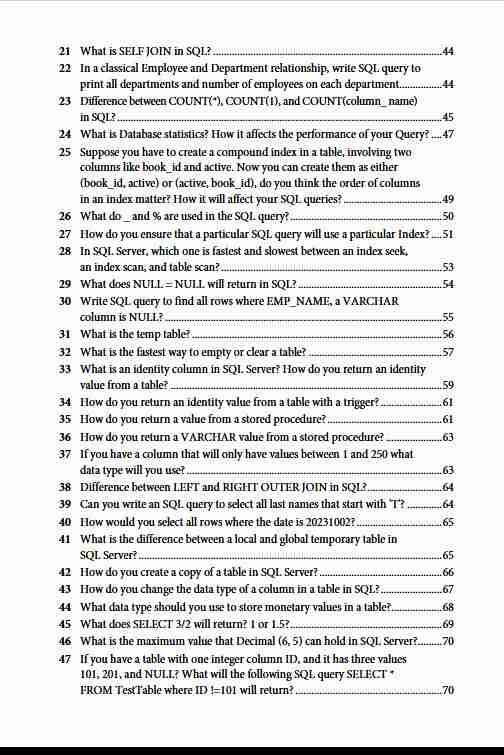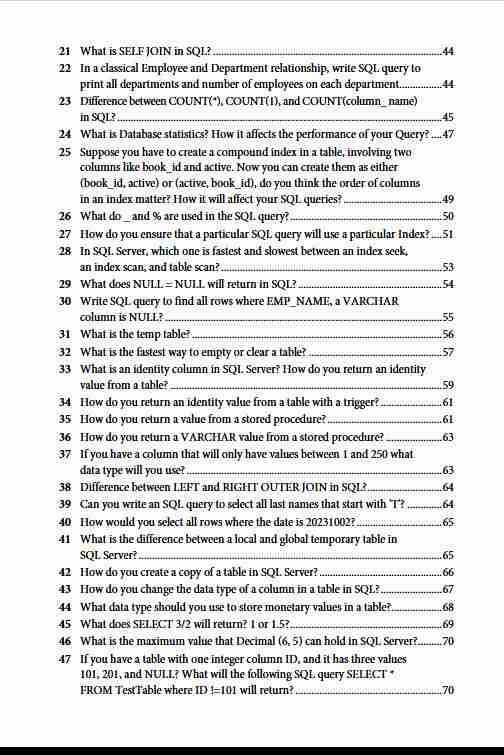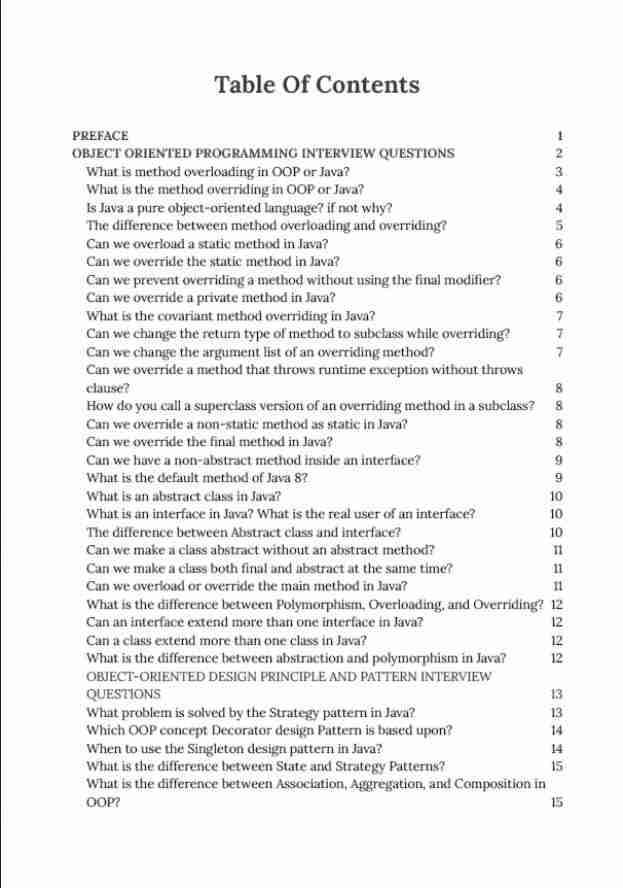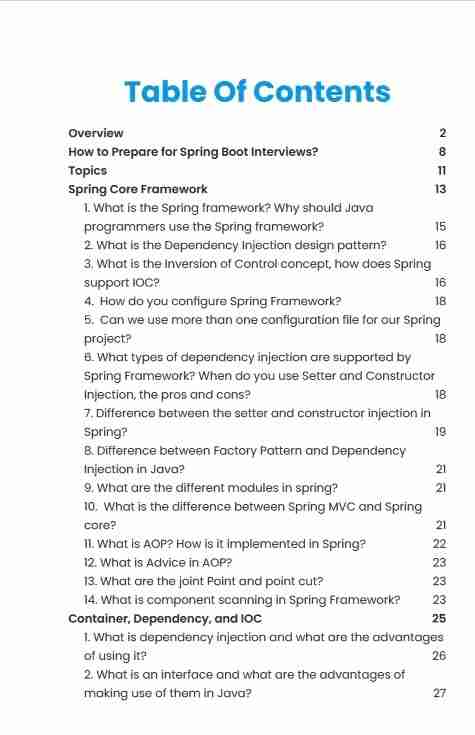
Disclosure: This post includes affiliate links; I may receive compensation if you purchase products or services from the different links provided in this article.
_

Hello devs, are you preparing for Java developer interviews? If Yes, here is a list of some useful Java interview questions for experienced Java programmers having experience in range of 2 to 5 years.
As an experienced developer you are expected to learn about OOP concepts, Java basics, Java Collection framework, Multi-threading and Concurrency utilities introduced in Java 5 and 6, Debugging Java application, Algorithm and Data structure, Some questions on design patterns, JVM and Garbage collection and couple of puzzles.
Actually its mix of everything you do in your day to day work.
If you are going for Java developer with some exposure on web development you will also be asked about popular Java frameworks like Spring, Hibernate, Struts 2.0 and others.
If you have more than 5 years of experience you can also expect questions about build tools like Maven, ANT and Gradle, Java best practices, Unit testing and JUnit and your experience about solving production issues.
One of the most common question I have faced is talking about the last production problem you have faced and how did you solved it.
If you are asked same question, give them step by step detail, right from analyzing problem to tactical fix to strategic solution.
In this article, I am going to share my list of Java Interview question for Java guys having 2 to 5 years of experience. Since I had similar experience couple of year ago, I know what questions are asked and keeping a list for your own always helps when you start looking for new challenge in your career.
I am not providing answers of these question in this post due to two reasons, questions are quite simple and you guys probably know the answer, second providing answer means I cannot use this post for my own preparation later, which is more important.
Though, I could write another article answering all these question if anyone request or I feel people need it.
By the way, if you are new to Java programming language or want to improve Java skills then you can also checkout sites like CodeGym, ZTM and karpado to learn Java by building Games and projects.

This list contains questions from different topics e.g. OOP concepts, multi-threading and concurrency, Java collections, Web services, Spring, Hibernate, Database and JDBC, it doesn't cover all topics you need to prepare.
I will add few more topics later when I have some time, for now, try to answer these questions without doing Google :)
Here are a couple of questions on OOP design, SOLID principle and baseic programming concepts
Loose coupling allows components to interact with each other with minimal dependencies, while tight coupling creates strong dependencies between components.
Cohesion refers to the degree to which elements within a module belong together, while coupling refers to the degree of interdependence between modules.
Liskov Substitution principle states that objects of a superclass should be replaceable with objects of its subclasses without affecting the correctness of the program.
For example, if you have a class hierarchy with a superclass "Shape" and subclasses "Circle" and "Square", any method that works with Shape should also work with Circle or Square without causing errors.
Abstract classes can have both abstract and concrete methods, while interfaces can only have abstract methods. Additionally, a class can implement multiple interfaces but can only extend one abstract class.
Composition implies a strong ownership relationship where the lifetime of the contained object is dependent on the container.
Aggregation implies a weaker relationship where the contained object can exist independently of the container. Association implies a relationship between two classes without any ownership or lifecycle dependency.
Now, let's see a few questions form Collections and Stream
Lists maintain elements in sequential order and allow duplicates (e.g., ArrayList, LinkedList). Sets do not allow duplicates and do not guarantee order (e.g., HashSet, TreeSet). Maps store key-value pairs and do not allow duplicate keys (e.g., HashMap, TreeMap).
Synchronized collections use explicit locking to achieve thread-safety, allowing only one thread to modify the collection at a time. Concurrent collections use non-blocking algorithms and are designed for high concurrency, allowing multiple threads to modify the collection concurrently without explicit locking.
The get method of HashMap calculates the hash code of the provided key, determines the index in the underlying array based on the hash code, and then searches for the key at that index. If found, it returns the corresponding value; otherwise, it returns null.
ConcurrentHashMap allows concurrent access to the map without blocking, while Hashtable uses synchronized methods to achieve thread-safety, resulting in potential performance bottlenecks. ConcurrentHashMap achieves thread-safety by dividing the map into segments, each with its lock, allowing multiple threads to modify different segments concurrently.
Use LinkedList when frequent insertion and deletion operations are required, as LinkedList provides constant-time insertion and deletion at any position. Use ArrayList when random access and iteration are frequent, as ArrayList provides constant-time access by index.
Now, its time to see questions from Java multithreading and concurrency concepts:
Both notify and notifyAll are methods in Java used to wake up threads waiting on a monitor (i.e., waiting to acquire an object's lock). notify wakes up one randomly selected thread, while notifyAll wakes up all waiting threads. notifyAll is preferred because it ensures that all waiting threads are notified, preventing potential indefinite waiting and improving system responsiveness.
A race condition occurs when the outcome of a program depends on the timing or interleaving of multiple threads. To avoid race conditions, you can use synchronization mechanisms like locks, semaphores, or atomic operations to ensure that critical sections of code are executed atomically or only by one thread at a time.
Deadlock occurs when two or more threads are stuck waiting for each other to release resources that they need to proceed. To avoid deadlock, you can use techniques such as resource ordering, avoiding nested locks, or using timeouts for acquiring locks. Additionally, designing code with a clear and consistent locking order can help prevent deadlocks.
Some high-level concurrency classes provided by java.util.concurrent include ExecutorService, ThreadPoolExecutor, CountDownLatch, Semaphore, CyclicBarrier, BlockingQueue, and ConcurrentHashMap. These classes provide thread-safe implementations of common concurrency patterns and mechanisms like thread pools, synchronization primitives, and concurrent data structures.
Yes, here is the code:
import java.util.concurrent.ArrayBlockingQueue;
class Producer implements Runnable {
private final ArrayBlockingQueue<Integer> queue;
private int count = 0;
Producer(ArrayBlockingQueue<Integer> queue) {
this.queue = queue;
}
public void run() {
try {
while (true) {
queue.put(produce());
Thread.sleep(1000); // Simulate some work
}
} catch (InterruptedException e) {
Thread.currentThread().interrupt();
}
}
private int produce() {
System.out.println("Producing: " + count);
return count++;
}
}
class Consumer implements Runnable {
private final ArrayBlockingQueue<Integer> queue;
Consumer(ArrayBlockingQueue<Integer> queue) {
this.queue = queue;
}
public void run() {
try {
while (true) {
consume(queue.take());
}
} catch (InterruptedException e) {
Thread.currentThread().interrupt();
}
}
private void consume(int item) {
System.out.println("Consuming: " + item);
}
}
public class Main {
public static void main(String[] args) {
ArrayBlockingQueue<Integer> queue = new ArrayBlockingQueue<>(10);
Producer producer = new Producer(queue);
Consumer consumer = new Consumer(queue);
Thread producerThread = new Thread(producer);
Thread consumerThread = new Thread(consumer);
producerThread.start();
consumerThread.start();
}
}
JDBC is used for connecting database from Java program, let's ee a few questions on Database and JDBC
To prevent SQL injection attacks, use parameterized queries (prepared statements) with bound parameters, input validation, and escape characters. Avoid dynamic SQL queries constructed by concatenating user input.
WHERE 절은 그룹화 및 집계 과정 전에 행을 필터링하고, HAVING 절은 그룹화 과정 이후에 지정된 조건에 따라 집계된 데이터를 필터링합니다.
트랜잭션은 단일 작업 단위로 실행되는 SQL 문 집합입니다. ACID는 원자성(Atomicity), 일관성(Consistency), 격리성(Isolation), 내구성(Durability)의 약자로 데이터베이스 시스템에서 트랜잭션의 신뢰성을 보장하는 속성입니다.
창 함수는 쿼리 결과 집합 내의 현재 행과 관련된 행 집합에 대해 계산을 수행합니다. 이를 사용하면 OVER 절로 정의된 지정된 창이나 행 하위 집합에 대해 집계 함수(예: SUM, AVG, COUNT)를 수행할 수 있습니다. 창 함수는 행 집합에서 작동하며 해당 행 집합을 기반으로 각 행에 대해 단일 값을 반환합니다. 순위 지정, 집계, 누계 계산 등의 작업에 자주 사용됩니다.
데이터베이스와 SQL에 대해 더 많은 질문이 필요하면 Grokking the SQL Interview 책을 참조하세요

이제 인기 있는 Java 프레임워크 중 하나인 Hibernate의 질문을 볼 시간입니다.
다음과 같은 경우 일반 SQL을 사용하는 것이 더 좋습니다.
Java에서 정렬된 컬렉션은 비교기나 요소의 자연 순서에 따라 정의된 특정 순서로 요소를 유지하는 반면, 정렬된 컬렉션은 삽입된 순서대로 요소를 유지합니다.
Hibernate의 두 번째 수준 캐시는 일반적으로 여러 세션에 걸쳐 공유 캐시 영역에 객체를 저장합니다. 엔터티가 처음으로 쿼리되면 데이터베이스에서 가져와 두 번째 수준 캐시에 저장됩니다. 그러면 동일한 엔터티에 대한 후속 쿼리가 데이터베이스에 도달하는 대신 캐시에서 처리되어 성능이 향상됩니다.
Hibernate의 save() 및 persist() 메소드는 모두 엔터티를 데이터베이스에 저장하는 데 사용됩니다. 그러나 save()는 생성된 식별자를 즉시 반환하는 반면, persist()는 SQL INSERT 문의 즉각적인 실행을 보장하지 않습니다. 나중에 플러시 시간 동안 실행될 수 있습니다. 또한 persist()는 JPA 사양의 일부인 반면 save()는 Hibernate에만 해당됩니다.
이제 마이크로서비스 아키텍처와 REST 웹 서비스에 대한 질문을 살펴보겠습니다
SOAP는 견고한 구조의 프로토콜 기반인 반면, REST는 유연한 엔드포인트를 갖춘 무상태 통신 기반 아키텍처 스타일입니다.
전체 SOAP 메시지를 캡슐화하고 구조를 정의합니다.
암호화 및 인증을 위해 SSL/TLS를 구현하세요.
HTTP 요청이나 응답의 본문에 전송되는 데이터입니다.
애플리케이션이 작고 독립적인 서비스들로 구성되는 아키텍처 스타일입니다.
마이크로서비스는 아키텍처 설계를 의미하는 반면 REST는 네트워크 애플리케이션을 위한 아키텍처 스타일을 의미합니다.
모놀리식에는 단일 코드베이스가 있는 반면 마이크로서비스에는 여러 개의 독립적인 구성 요소가 있습니다. 모놀리식은 지연 시간이 더 길 수 있습니다.
마이크로서비스 아키텍처에서 분산 트랜잭션을 관리합니다.
마이크로서비스 아키텍처 내에서 동적으로 서비스를 찾는 메커니즘입니다.
저는 Java 및 Spring 개발자 인터뷰 전에 항상 Grokking the Java Interview와 Grokking the Spring boot Interviw를 읽습니다
다음은 이 책에서 몇 가지 추가 질문입니다.

그리고

또한 Java를 처음 사용하는 경우 CodeGym, ZTM 및 karpado와 같은 사이트에서 게임 및 프로젝트를 구축하여 Java를 배울 수도 있습니다.
지금은 감사합니다. 웹에서 답변을 쉽게 찾을 수 있지만 관심이 충분하다면 게시물을 업데이트할 수도 있습니다. 이전에도 이러한 질문을 한 적이 있는지 알려주세요. 답을 아시는 분은 댓글로 달아주셔도 됩니다.
Java 인터뷰에 행운이 있기를 바랍니다.
그런데, Java 프로그래밍 언어를 처음 접하거나 Java 기술을 향상시키고 싶다면 다음 최고의 Java 강좌를 확인하여 실력을 향상할 수도 있습니다.
The above is the detailed content of Java Interview Questions Answers for Practice. For more information, please follow other related articles on the PHP Chinese website!




